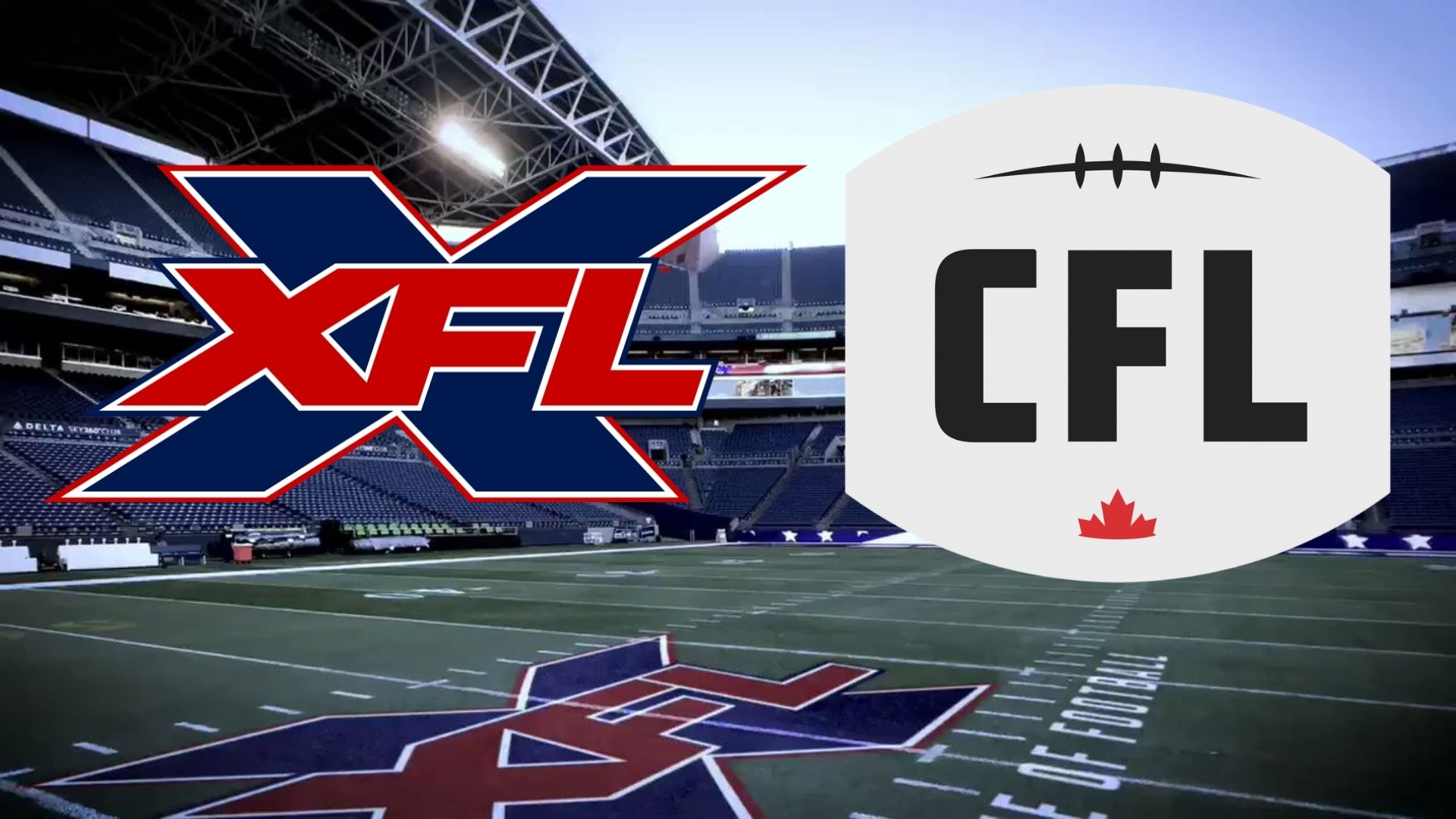
The XFL and CFL are in deep talks about making their futures work together. Will it lead to a full-scale merger between the two leagues, and how would that work exactly?
Discussions between both the XFL and CFL are on-going, and there is so much that needs to be sorted out between the two leagues.
The bottom line is that the XFL wouldn’t be in pause mode for 2022 if these talks were merely a standard working agreement, where the leagues share players, ideas, business opportunities, cross-promotion, etc.
There are two things that supporters and many current/prospective XFL and CFL employees don’t want to hear: Firstly, that the XFL will not be returning to play in 2022, and secondly, from the CFL side, that their 3-down style of football will be no more.
With the CFL, and its most ardent longtime supporters, there’s the issue of shunning its history, and with the XFL, it’s all about redirecting and further delaying its uncertain future.
How does one go about marrying two different leagues and all of their concepts without enraging all the in-laws that get roped up into this marriage? Can the two leagues find a happy medium to become one without alienating the fan bases or their employees?
Before we can proceed towards what an XFL-CFL hybrid league could look like on the field. Let’s get the boring stuff out of the way, which is of utmost importance.
OWNERSHIP STRUCTURE
As presently constituted, the XFL is a single-entity model with all of its teams owned by the league itself. In this case, Dany Garcia, Dwayne Johnson, Gerry Cardinale, and RedBird Capital Partners.
Unless the XFL decides to change that model and start selling off individual franchises, which would be a challenging task in any environment, let alone the current landscape, the league figures to stick with its single-entity approach for now.
The CFL’s nine teams have six private owners and three community-owned. (The Edmonton Football Team, Saskatchewan Roughriders, and the Winnipeg Blue Bombers). The estate of the late David Braley owns the BC Lions.
Any potential merger could disrupt and alter many of the current business dealings and relationships that the CFL has. Deciding how to split the economic power between both leagues could be very difficult to navigate. That’s provided that the leagues don’t operate separately.
There have been rumblings in the past that some CFL franchises are unwilling to proceed without the league undergoing a grand reorganization plan. That’s where the XFL comes into play.
Reports are that the CFL lost upwards of 50-80 million dollars due to the cancellation of their season in 2020.
Consider this; there were indications that the BC Lions, Toronto Argonauts, and the Montreal Alouettes lost more money in 2019 than they did last year with the cancelation. The reports track because of those teams’ abysmal attendance figures. (BC 17k, Montreal 17k & Toronto 13k avg)
The CFL’s regular-season attendance in 2019 was down for the eighth year in a row. Largely because of the struggles of Montreal, Toronto, and BC.
The continued financial struggles are why some CFL teams are motivated to see what the XFL can offer.
Barring a full-scale buyout by RedBird Capital of the CFL. Finding a way to make the different ownership models work together will be crucial and challenging.
The conversation between both leagues is more straightforward. It’s a matter of three questions, what can we do for each other, what do we want to build in the future, and how can we help each other do that? The sooner the XFL and CFL get to those answers, the faster they can journey in a new world together.
AN XFL-CFL HYBRID LEAGUE
One of the best selling points about the XFL in 2020 was their goal of reimagining football and how it was presented on and off the field.
To a large extent, the XFL succeeded in doing so with great fanfare. College Football, The NFL, and sports leagues will be copying what the XFL started in 2020. It’s already started.
Evident in the social media of sports teams and in the rules/innovations that leagues are looking to adopt/borrow from the XFL in the future. (See the Sky Judge/Officiating/Technology/Overtime/Gambling etc.)
The fun part about this potential unity between the CFL and XFL is to reimagine a merger concept. And you can borrow some elements from the past while also retaining the individual personalities of each league.
Humor me for a bit and imagine, if you will, the XFL and CFL being run as two separate conferences/leagues. With both leagues playing their seasons side by side at the same time. Similar to the early days of the AFL and NFL before their merger.
An 18 team league. Nine XFL teams, with the addition of one new expansion team. Perhaps San Antonio or Birmingham (Smile AAF fans) and the nine existing CFL teams. A model that can expand to twenty teams by year two of the merger.
Like the early days of the USFL, The CFL and XFL could play a five or even six-month schedule starting sometime after the Superbowl that runs until the summer. With inter-league games distributed evenly throughout the season.
In theory, the season can start sometime after the Superbowl and go right up until the start of NFL training camps or even the NFL season. The timeline still gives players from both leagues a chance to latch onto NFL teams, and ultimately, this timeline keeps the leagues away from competing directly with the college game or the NFL for attention.
There’s one caveat to all of this besides the weather in Canada in potentially March. TSN, the CFL’s TV partner, from sources I have spoken to, wants the league games on their networks in July and August. A season that extends into late August would be pivotal for the Canadian Game’s best tv partner.
From the spring until the summer, the XFL and CFL can own the football calendar. Imagine weeks during the season, where there are five straight days of XFL and CFL games on TV every Thursday through Monday. (So that games from both leagues can run unopposed.) With multiple TV and streaming partners airing the games.
At season’s end, once the playoffs conclude and an XFL and Grey Cup champion are crowned, those two teams play each other in an ultimate championship game.
Sounds bizarre, right? Except that’s what the Superbowl was initially. AFL champ versus NFL champ. At the time, that particular concept wasn’t viewed favorably and was characterized as a gimmick.
Here’s the kicker and the million-dollar question, What rules do these two leagues play?
The answer; there’s no need to abandon the rules of either league. The merger can incorporate some of the great concepts from both leagues. (Gambling, officiating, the kickoff, forward motion, punt rules, etc.)
Ultimately this pipedream vision is that the CFL plays games under their rules, and the XFL does the same.
In interleague games, the home team plays their league’s rules. By doing this, you don’t have to search for or modify any fields in Canada or the United States.
It sounds crazy and maybe a bit gimmicky, but the St. Louis BattleHawks traveling to the Toronto Argonauts during the season to play a game under CFL rules would be fun. Tough on the road team for sure, but not uncommon for sports teams playing interleague games under different rules.
I realize that there’s a big difference between this, in terms of competitive advantage, and for example, the DH rule in baseball, but it’s not entirely out of left field. (pardon the pun). Interleague games would not be the norm and wouldn’t greatly affect either the CFL or XFL during a season.
The makeup of all 18 team rosters in year one can also lend itself towards keeping some of the same territorial style rules that the CFL already has and that the AAF implemented.
Ultimately, this type of hybrid league would be a ‘when worlds collide’ type concept. It’s a longshot and far from perfect, but it’s a way to keep both styles of league play intact.
THE ENDGAME
What is the end game after all for both the XFL and CFL? To expand their league’s reach and grow in popularity.
In this type of merger, the CFL can expand its business model and reintroduce its game to a new audience while reinvigorating its product in its own country.
For the XFL, they can do a lot of the same. They can journey into an area that the NFL hasn’t captured. The way that the NBA has with the Toronto Raptors.
Setting aside the obvious financial risks of going big. Having an 18 team league for the XFL specifically means more games, which in turn means more ticket sales, more games to sell to sponsors, and more games to sell to network and streaming partners.
The possibilities are endless for producing complementary reality-based content and creating revenue streams for both leagues as one. Especially with Dany Garcia and Dwayne ‘The Rock’ Johnson involved.
One of the reasons that first-year leagues struggle to maintain a large share of TV audiences is directly correlated with their size. Fewer markets are interested in the games when you have a modest amount of teams. Revenues are also limited when you are only selling the league in eight or nine cities.
In a way, the XFL merging with the CFL is both of them doubling the size of their leagues.
There’s a catch to all of this madness in playing fantasy league builder.
To accomplish this monumental undertaking effectively, it’s very likely that we don’t see an XFL-CFL merger-style league play out in March of 2022. There will be way too many moving parts to make this all happen in less than a year. It’s not impossible but not probable.
At the end of the day, the reality is that this might end up being a situation where the XFL’s style and rules make their way into Canada, with a new CFL emerging. And with the old CFL fading away for a new fresher model. Until then, I can dream, right?
In 2019, I had this same dream when the AAF launched, and the XFL was on the horizon heading towards 2020. A scenario that I envisioned and hoped for was an XFL-AAF merger by 2021 or 2022. Business as it often does and did put an end to that fantasy.
I never figured that the CFL could be taking the Alliance’s place in my pipedream scenario. The thing with this new dream, though, is that business might get in the way again.
Unleash the Action: Sign up for XFL Insider and Fuel Your Passion for Football!
I am a pro football writer who has extensively covered and reported on multiple leagues over the years. I started covering the XFL back in 2001. You can follow me on Twitter @byMikeMitchell

USFL and XFL Merger: A Deep Dive into the Historic Collaboration
Latest Podcast
-


XFL Podcast
/ 1 year agoXFL-USFL Merger Insights: Houston’s Future, Draft News, Player Movement – Ep. 216
Welcome to Episode 216 of the “XFL Week In Review,” your premier destination for...
By Mark Perry







